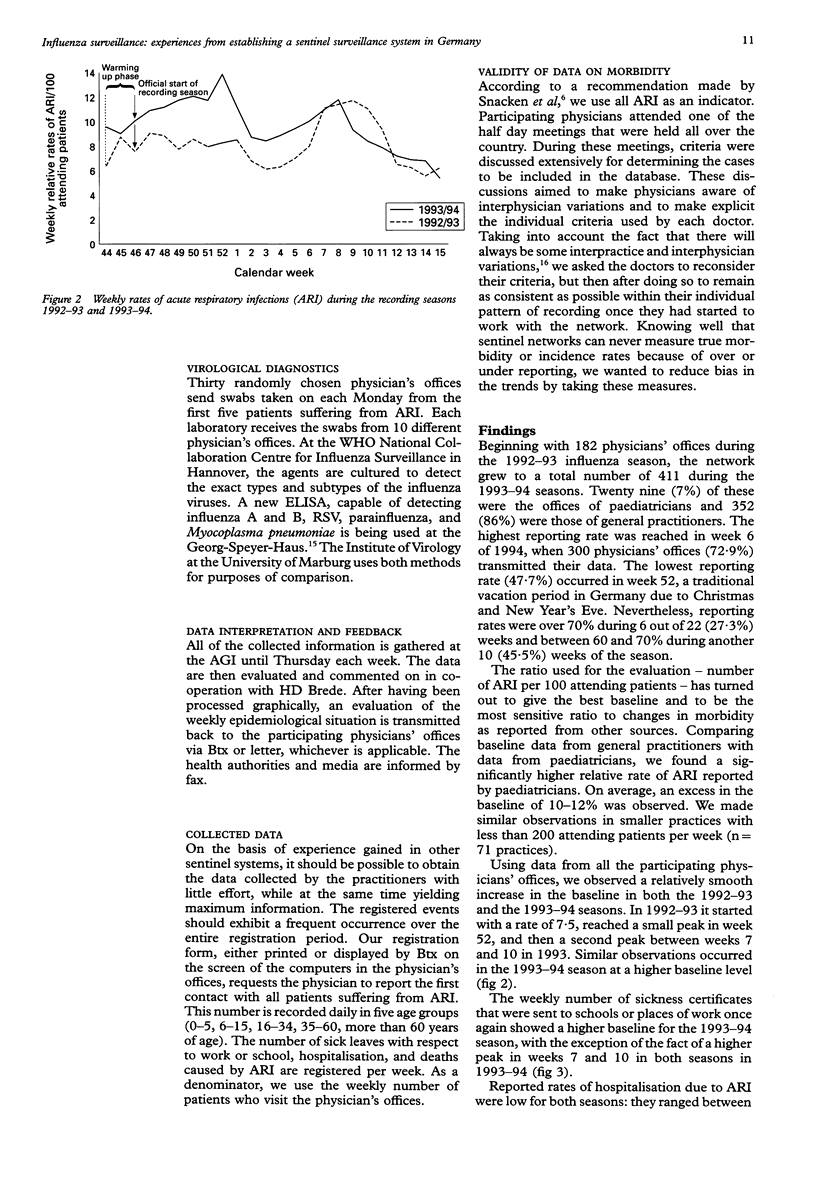Abstract
OBJECTIVES--Before and during peak influenza periods there is increased morbidity from other respiratory tract disorders. Sentinel networks of primary care physicians can be very effective in the early detection of influenza epidemics and the German network, the Arbeitsgemeinschaft Influenza (AGI), began its work in this area in 1992. METHODS--Data are transmitted weekly from the doctor's computer via Btx to a central computer. The numerator is the weekly number of acute respiratory infections (ARI) in five age groups and the denominator is the weekly number of patient consultations. Data on hospitalisation, mortality, and days of sick leave from work or school are also collected. Swabs for influenza specimens are collected in 30 physicians' offices each Monday and sent to three reference centres. FINDINGS--During the last recording period, from week 46 1993 to week 15 1994, 411 physicians' offices participated in the network. For 16 to 22 weeks, more than 60% of the participants transmitted data. During both the 1992-93 and 1993-94 influenza seasons, peaks were observed in the rate of ARI. There was a corresponding increase in sick leave from work and school. Rates for hospitalisation and deaths due to influenza showed no peaks during either season. CONCLUSIONS--Although the German sentinel network for influenza experienced some technical problems in the first year, it was possible to solve these. Reporting rates were very satisfactory in the second year. The network will now be expanded to include 750 physicians in order to receive 600 weekly reports and obtain a solid baseline for an early warning system.
Full text
PDF




Selected References
These references are in PubMed. This may not be the complete list of references from this article.
- Buffington J., Chapman L. E., Schmeltz L. M., Kendal A. P. Do family physicians make good sentinels for influenza? Arch Fam Med. 1993 Aug;2(8):859–865. doi: 10.1001/archfami.2.8.859. [DOI] [PubMed] [Google Scholar]
- Costagliola D., Flahault A., Galinec D., Garnerin P., Menares J., Valleron A. J. A routine tool for detection and assessment of epidemics of influenza-like syndromes in France. Am J Public Health. 1991 Jan;81(1):97–99. doi: 10.2105/ajph.81.1.97. [DOI] [PMC free article] [PubMed] [Google Scholar]
- Crombie D. L., Cross K. W., Fleming D. M. The problem of diagnostic variability in general practice. J Epidemiol Community Health. 1992 Aug;46(4):447–454. doi: 10.1136/jech.46.4.447. [DOI] [PMC free article] [PubMed] [Google Scholar]
- Döller G., Schuy W., Tjhen K. Y., Stekeler B., Gerth H. J. Direct detection of influenza virus antigen in nasopharyngeal specimens by direct enzyme immunoassay in comparison with quantitating virus shedding. J Clin Microbiol. 1992 Apr;30(4):866–869. doi: 10.1128/jcm.30.4.866-869.1992. [DOI] [PMC free article] [PubMed] [Google Scholar]
- Fleming D. M., Ayres J. G. Diagnosis and patterns of incidence of influenza, influenza-like illness and the common cold in general practice. J R Coll Gen Pract. 1988 Apr;38(309):159–162. [PMC free article] [PubMed] [Google Scholar]
- Fleming D. M., Cross K. W., Crombie D. L., Lancashire R. J. Respiratory illness and mortality in England and Wales. A study of the relationships between weekly data for the incidence of respiratory disease presenting to general practitioners, and registered deaths. Eur J Epidemiol. 1993 Nov;9(6):571–576. doi: 10.1007/BF00211429. [DOI] [PubMed] [Google Scholar]
- Fleming D. M., Cross K. W. Respiratory syncytial virus or influenza? Lancet. 1993 Dec 18;342(8886-8887):1507–1510. doi: 10.1016/s0140-6736(05)80082-0. [DOI] [PubMed] [Google Scholar]
- Fleming D. M. The measurement of morbidity in general practice. J Epidemiol Community Health. 1991 Sep;45(3):180–183. doi: 10.1136/jech.45.3.180. [DOI] [PMC free article] [PubMed] [Google Scholar]
- McBean A. M., Babish J. D., Warren J. L. The impact and cost of influenza in the elderly. Arch Intern Med. 1993 Sep 27;153(18):2105–2111. [PubMed] [Google Scholar]
- McDonald C. J., Hui S. L., Tierney W. M. Effects of computer reminders for influenza vaccination on morbidity during influenza epidemics. MD Comput. 1992 Sep-Oct;9(5):304–312. [PubMed] [Google Scholar]
- Snacken R., Lion J., Van Casteren V., Cornelis R., Yane F., Mombaerts M., Aelvoet W., Stroobant A. Five years of sentinel surveillance of acute respiratory infections (1985-1990): the benefits of an influenza early warning system. Eur J Epidemiol. 1992 Jul;8(4):485–490. doi: 10.1007/BF00146364. [DOI] [PubMed] [Google Scholar]


